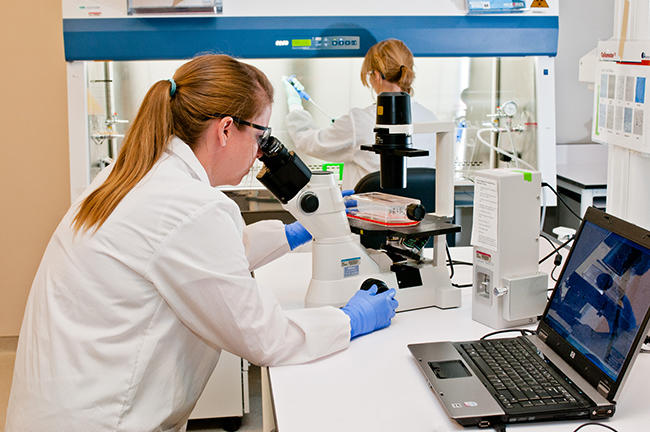Cancer Complexity Knowledge Portal
This Community Research resource provides information about and access to data, research, tools, and publications generated through the Cancer Systems Biology Consortium (CSBC), the Physical Sciences - Oncology Network (PS-ON), and the Cancer Tissue Engineering Collaborative (TEC).
For more information, please visit the Cancer Complexity Knowledge Portal.
Chernobyl Tissue Bank (CTB)
NCI supports and manages biospecimen resources that collect, store, process, and disseminate human biological specimens (biospecimens) and associated data set for research on human cancer biology. The Chernobyl Tissue Bank is an international collaborative project that is supported by NCI and another global partner, with active participation from Russia and Ukraine, two countries heavily affected by the 1986 Chernobyl accident. The objective of the CTB is to establish and maintain a research resource that supports studies on the biology of thyroid cancer, the major health consequence of the Chernobyl accident.
For more information on this Tissue Bank, please visit the Chernobyl Tissue Bank website.
GM/CA X-ray Beamline
NCI partnered with the National Institute of General Medical Sciences (NIGMS) to fund the construction and management of a state-of-the-art macromolecular crystallography synchrotron beamline for determining structures of biologically important macromolecules. The beamline, GM/CA CAT, is located at the Advanced Photon Source on the grounds of Argonne National Lab just outside of Chicago.
NCI has a significant amount of beamtime dedicated for the use of its grantees. Investigators interested in taking experiments to this facility should contact the beamline directly or email Dr. Anowarul Amin for additional information.
International Registry of Werner Syndrome
The International Registry of Werner Syndrome is the primary repository of samples and data from patients with Werner Syndrome (WS), and was established in 1988 as part of an objective to positionally clone the WS gene.
The registry ascertains and genotypes new pedigree cases from around the world, using lymphoblastoids and/or fibroblasts from human research participants, and provides genetic confirmation of classical WS. It also establishes and cryopreserves cell lines and other material from these pedigrees (both affected patients and their clinically unaffected siblings), including Epstein-Barr transformed peripheral blood B lymphocytes, primary skin fibroblasts, immortalized skin fibroblasts, WRN cDNA constructs, and others. All these materials are available for research.
For more information on this Registry, please visit the Werner Syndrome Registry website.
NCI Mouse Repository
The NCI Mouse Repository is an NCI-funded resource for mouse cancer models and associated strains. The repository makes strains available to all members of the scientific community (academic, non-profit, and commercial). NCI Mouse Repository strains are cryoarchived and distributed as frozen germoplasm (embryos and/or sperm).
MicroRNAs (miRNAs) are small non-coding RNA molecules known to play an important role in fundamental cellular processes through negative post-transcriptional regulation of gene expression. In an effort to address the role that microRNAs play in human cancer, their use as diagnostic tools, and their potential function as new targets for therapeutic intervention in the treatment of cancer, the Division of Cancer Biology (DCB) of the National Cancer Institute (NCI) has supported the generation of mouse embryonic stem cells (mESCs) harboring most known mouse miRNAs. In order to enhance novel information obtained on their role in cancer, 1501 genetically engineered mESC lines were produced, harboring conditional microRNA transgenes.
For more information, please visit the NCI Mouse Repository website.
NIH MHC Tetramer Program
This core facility provides custom synthesis and distribution of soluble MHC-peptide tetramer reagents that can be used to stain antigen-specific T cells. The facility is supported by a contract from the National Institute of Allergy and Infectious Diseases, with steering committee participation from NCI through DCB.
For more information about this program, please visit the Emory University tetramer website.
Office of Cancer Genomics (OCG) Resources
OCG shares genomic resources and data with the research community:
Biomedical Citizen Science and Crowdsourcing: The NIH Citizen Science Working Group
This trans-NIH working group is investigating the usefulness and possible incorporation of citizen science methodologies into biomedical research in a way that maintains NIH’s high scientific and ethical standards.
Citizen science is a collaborative approach to research involving the public as direct collaborators and partners in the research process itself — not just as subjects of the research or advisors to the research. Citizen science takes many forms, and involves a variety of approaches benefiting from the creativity and problem-solving skills of the public and from citizen-collected data and insights not obtainable through conventional approaches.
This working group investigates, shares best practices, and engages in discussion with other agencies and groups promoting citizen science in other fields. The working group is composed of program officers, scientific review officers, and others from across NIH interested in furthering the adoption and incorporation of citizen science methodology into biomedical research.
